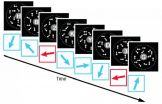(Press-News.org) PROVIDENCE, R.I. [Brown University] -- A new study led by Brown University reports that older learners retained the mental flexibility needed to learn a visual perception task but were not as good as younger people at filtering out irrelevant information.
The findings undermine the conventional wisdom that the brains of older people lack flexibility, or "plasticity," but highlight a different reason why learning may become more difficult as people age: They learn more than they need to. Researchers call this the "plasticity and stability dilemma." The new study suggests older people may indeed be facing it.
"Plasticity may be kept OK, in contrast with the view of many researchers on aging who have said that the degree of plasticity of older people gets lower," said Takeo Watanabe, the Fred M. Seed Professor at Brown University, corresponding author of the study in Current Biology. "However, we have found that the stability is problematic. Our learning and memory capability is limited. You don't want older, existing important information that is already stored to be replaced with trivial information."
Numerals, not dots
To conduct the study, Watanabe and his team enrolled a group of 10 people between 67 and 79 years old and another group of 10 people ages 19 to 30 for an experiment. Over a nine-day period, they trained on a simple visual exercise: Shown a quick sequence of six symbols - four letters and two numerals - volunteers were asked to report the numerals they saw. Their performance on a test at the end of training was compared to their score on a pre-test.
The volunteers were explicitly instructed to only bother with spotting the two numerals, but each symbol they saw had a background of moving dots. Unbeknownst to the subjects, those dots would move with varying degrees of cohesiveness of direction. In the pre- and post-tests the researchers also asked the volunteers to report the direction of dot movement when they saw the numerals.
The results of the testing were telling. Older people improved as much as younger people on the relevant task of identifying the two numerals.
"These results indicate that older subjects as well as younger subjects showed significant amounts of task-relevant learning," the authors wrote. "No evidence was obtained that indicates that older individuals have a problem with plasticity."
Last week, in fact, Watanabe and colleagues published a study showing that plasticity during visual learning occurs in older people as well as younger ones, but it is manifest differently in the brains of the different groups.
But in this study when it came to the irrelevant skill of discerning the prevailing direction of dot movement, older people learned that, too, even when it was at its most obvious. Younger people, meanwhile, only showed improvement on discerning movement when it was insidiously subtle. If it was clear, they recognized it and filtered it out.
The idea that the most obvious signals were the most easily filtered, suggested that the difference between older and younger learners was a matter of attention.
The researchers therefore subjected the volunteers to another test for the ability to find a relevant stimulus amid a number of distractors. Older people did notably worse than younger ones, adding evidence that the attentional systems for filtering out irrelevant stimuli were indeed weaker in older learners. Importantly, the poorer an older subject was at the ability to filter out irrelevant stimuli, the more irrelevant stimuli the subject learned.
Watanabe said the finding is not necessarily discouraging news. Perhaps filtering can be improved with some kind of training.
"The hope is that maybe what older people need to do is to learn a skill to avoid learning what is not necessary," he said.
INFORMATION:
In addition to Watanabe, other authors of the paper are Li-Hung Chang, formerly of Brown but now of National Yang-Ming University in Taiwan; Yuka Sasaki, associate professor (research) of cognitive, linguistic, and psychological sciences, and Kazuhisa Shibata of Brown; and George Andersen of the University of California-Riverside.
The National Institutes of Health supported the study (grants: R01EY019466, R01AG031941, R01MH091801).
VIDEO:
When people hear another person talking to them, they respond not only to what is being said -- those consonants and vowels strung together into words and sentences --but also...
Click here for more information.
When people hear another person talking to them, they respond not only to what is being said--those consonants and vowels strung together into words and sentences--but also to other features of that speech--the emotional tone and the speaker's gender, for instance. ...
Older people can actually take in and learn from visual information more readily than younger people do, according to new evidence reported in the Cell Press journal Current Biology on November 26. This surprising discovery is explained by an apparent decline with age in the ability to filter out irrelevant information.
"It is quite counterintuitive that there is a case in which older individuals learn more than younger individuals," says Takeo Watanabe of Brown University.
Older individuals take in more at the same time as the stability of their visual perceptual ...
Enzymes inside cells that normally repair damaged DNA sometimes wreck it instead, researchers at the Stanford University School of Medicine have found. The insight could lead to a better understanding of the causes of some types of cancer and neurodegenerative disease.
In a paper to be published online Nov. 27 in Molecular Cell, the researchers explain how the recently discovered mechanism of DNA damage occurs when genetic transcripts, composed of RNA, stick to the DNA instead of detaching from it.
Certain enzymes, called endonucleases, are attracted to DNA/RNA hybrids ...
Researchers at the Center for iPS Cell Research and Application (CiRA), Kyoto University, show that induced pluripotent stem (iPS) cells can be used to correct genetic mutations that cause Duchenne muscular dystrophy (DMD). The research, published in Stem Cell Reports, demonstrates how engineered nucleases, such as TALEN and CRISPR, can be used to edit the genome of iPS cells generated from the skin cells of a DMD patient. The cells were then differentiated into skeletal muscles, in which the mutation responsible for DMD had disappeared.
DMD is a severe muscular degenerative ...
Mutations in the KRAS gene have long been known to cause cancer, and about one third of solid tumors have KRAS mutations or mutations in the KRAS pathway. KRAS promotes cancer formation not only by driving cell growth and division, but also by turning off protective tumor suppressor genes, which normally limit uncontrolled cell growth and cause damaged cells to self-destruct.
A new University of Iowa study provided a deeper understanding of how KRAS turns off tumor suppressor genes and identifies a key enzyme in the process. The findings, published online Nov. 26 in the ...
SALT LAKE CITY--Researchers from Huntsman Cancer Institute (HCI) at the University of Utah (U of U) discovered the unusual role of lactate in the metabolism of alveolar soft part sarcoma (ASPS), a rare, aggressive cancer that primarily affects adolescents and young adults. The study also confirmed that a fusion gene is the cancer-causing agent in this disease. The research results were published online in the journal Cancer Cell Nov. 26, 2014.
ASPS tumor cells contain a chromosomal translocation--strands of DNA from two chromosomes trade places. The two strands fuse ...
MINNEAPOLIS / ST. PAUL (11/26/2014)--During a thunderstorm, we all know that it is common to hear thunder after we see the lightning. That's because sound travels much slower (768 miles per hour) than light (670,000,000 miles per hour).
Now, University of Minnesota engineering researchers have developed a chip on which both sound wave and light wave are generated and confined together so that the sound can very efficiently control the light. The novel device platform could improve wireless communications systems using optical fibers and ultimately be used for computation ...
In recent years it has been established that copper plays an essential role in the health of the human brain. Improper copper oxidation has been linked to several neurological disorders including Alzheimer's, Parkinson's, Menkes' and Wilson's. Copper has also been identified as a critical ingredient in the enzymes that activate the brain's neurotransmitters in response to stimuli. Now a new study by researchers with the U.S. Department of Energy (DOE)'s Lawrence Berkeley National Laboratory (Berkeley Lab) has shown that proper copper levels are also essential to the health ...
Lincoln, Neb., Nov. 26, 2014 -- By solving a six-dimensional equation that had previously stymied researchers, University of Nebraska-Lincoln physicists have pinpointed the characteristics of a laser pulse that yields electron behavior they can predict and essentially control.
It's long been known that laser pulses of sufficient intensity can produce enough energy to eject electrons from their ultrafast orbits around an atom, causing ionization.
An international team led by the UNL researchers has demonstrated that the angles at which two electrons launch from a helium ...
The Tropical Rainfall Measuring Mission or TRMM satellite provided rainfall data as Tropical Depression 21W was making landfall in the southern Philippines on Nov. 26.
TRMM revealed areas of heavy rainfall in fragmented bands east of the center of circulation, where rain was falling at more than 1 inch (25 mm) per hour. TRMM rainfall data was overlaid on infrared data from the Japan Meteorological Agency's MTSAT-1 satellite that showed Tropical Depression 21W's (TD21W) clouds extended from western Mindanao, east into the Philippine Sea.
On Nov. 26, there were a number ...







